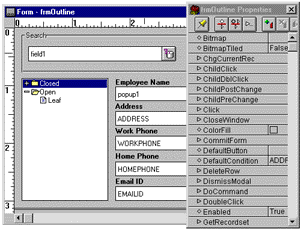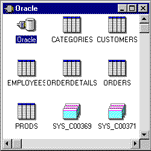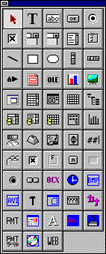
Combining the agility of popular visual programming environments with the robust data-handling capabilities of enterprise-level client/server tools, Oracle Power Objects enables developers to deliver powerful client/server applications easier, faster, and with less code than ever before.
Oracle Power Objects has been architected solely for client/server applications not general purpose GUI development. Oracle Power Objects is built on an Intelligent Data Management architecture that manages complex relational database functionality at the object level, not at a coding level. By selecting options from a simple property sheet, developers can easily set master-detail creation, multi-form referential integrity, cascading deletes and updates, transaction management, and row-fetch parameters.

Power Objects Form and Property Sheet Windows
Rather than relying on Wizards or Experts, Oracle Power Objects is the first development tool to incorporate "drag and drop" everything. To upsize a table, just go to the Session Manager and drag and drop. To downsize a database, just drag and drop. You can even migrate a database from one database server to another the very same way.
Oracle Power Objects lets you create reusable application components visually with true, multilevel inheritance from within the product. To propagate them to multiple applications, just drag and drop. No coding, no header file declarations, no dropping out to a low-level language like C++. Oracle Power Objects delivers the true benefits of object-oriented programming, namely code reusability, in a way that any developer can master.

You can develop applications anytime, anywhere with the compact, SQL '92-compliant Blaze local database. Included with Oracle Power Objects, Blaze is fully upwardly compatible with Oracle7. Blaze tables can be upsized to any of the supported database servers through drag-and-drop.
Oracle Power Objects is bundled with native data drivers providing high-performance, full-function access to Oracle7, as well as Microsoft SQL Server and Sybase SQL Server. Oracle Power Objects ensures maximum server processing and application performance. You can create, modify, or restructure database tables, generate indexes and sequence numbers, or create true database views (instead of query scripts) right on the database server.
Designed from the ground up to support cross-platform application development, Oracle Power Objects is available for both the Windows 3.1 operating environment and the Macintosh operating system. While each version is fully optimized for its native operating environment, applications developed with Oracle Power Objects are completely portable. For example, an application developed on Windows can run unmodified on Macintosh.You can develop and deploy Oracle Power Objects applications on machines with as little as eight megabytes of RAM with room to spare, for all supported platforms. True cross-platform portability and low resource requirements allow you to maintain one set of application source-code that supports all your users.
For maximum extensibility, Oracle Power Objects supports a wide array of industry standards, including OCX controls, OLE 2.0. Developers can also call .DLL's under Windows everything you need for rapid application development. The Oracle BASIC scripting language is syntax-compatible with standard BASIC.
Oracle Power Objects is designed to be fully localized so that users around the world can develop and deploy client/server applications in their native languages. To start, native Japanese, Korean, and Spanish versions will be released within six months of the English version. No matter where your applications need to run, Oracle Power Objects is the one tool you can use anywhere in the world.
Hardware and Software Requirements
- 386 or higher (486 recommended) IBM/Compaq compatible PC or Macintosh 68020 or higher
- 8 MB RAM and 10 MB disk space
- Windows Version 3.x or Macintosh System 7.x
Database Connectivity
- Native Oracle7 driver for any Oracle7 database
- Native Sybase SQL Server driver (Version 4.2 or higher)
- Native Microsoft SQL Server driver (Version 4.2 or higher)
- Local database
Integrated Database Session Manager
- Create, modify, restructure, view, and edit tables
- Create and modify table indexes
- Create and modify database Views
- Create database sequence numbers
- Assign connection information
- Drag-and-drop data migration and "upsizing"
- Built-in transaction control and integrity checks
Integrated Development Environment
- Graphical application manager displays all
application components

- Full support for .DLL calls under Windows, OCX controls, and OLE 2.0.
- Create reusable application components directly in the product
- Full access to Windows API calls
- Integrated graphical forms designer
- Property sheet allows customization of components without code
- Built-in tools for alignment and tab order
- Standard components for buttons, check boxes, radio buttons, list boxes, combo boxes, graphics, text fields, and more
- Data Aware objects for data fields, repeater controls, scroll bars, and more
- Extensible through standard .OCX controls
- Support for embedded 2D and 3D graphs
- Integrated Query-by-Form capability
- Integrated graphical banded report writer
- Adaptive load balancing for any data size
- Custom group specifications
- Multilevel sorting
- On-screen print preview
- Integrated BASIC Editor, Debugger, and Compiler
- Full graphical debugging
- Graphical object hierarchy diagram
- Conditional breakpoints
- Conditional watchpoints
- Step-through, Step-in, Step-over code execution tracing
- Evaluate and modify expressions and variables
- Creates fast standalone .EXEs (including connectivity) without runtime fees
- Oracle BASIC Language
- Uses same syntax as Microsoft Visual Basic
- Structured, object-oriented language
- Full support for inheritance, polymorphism, and encapsulation
- Runtime type information and object persistence
- Blaze Local Database
- SQL-based
- Supports computed fields
- Supports outer-joins and join expressions
- Binary field support for multimedia applications
- Upward compatible with Oracle7
- Perfect for standalone prototyping and applications
Documentation
- Over 5 MB of online help/documentation
- Three illustrated manuals
- Over 5 MB of sample applications with full source code
- Runtime